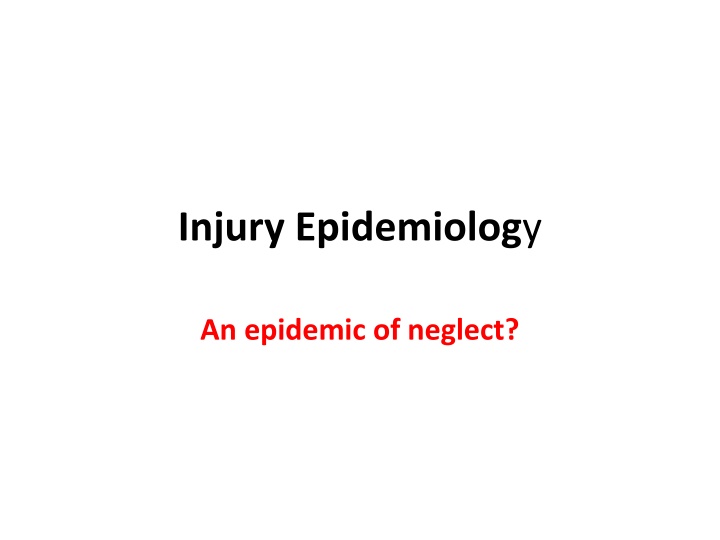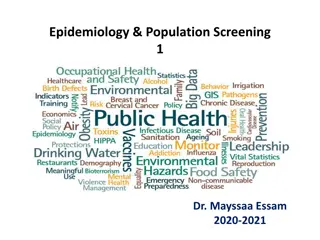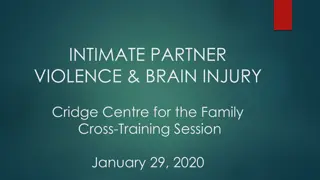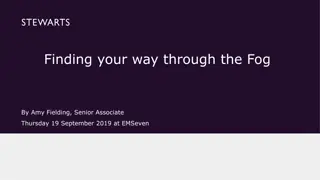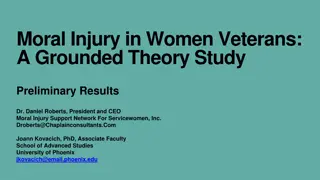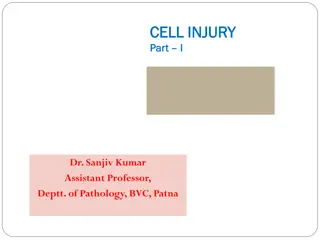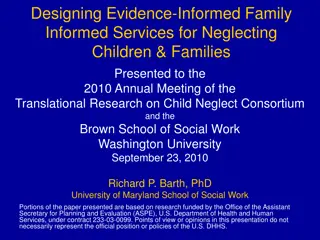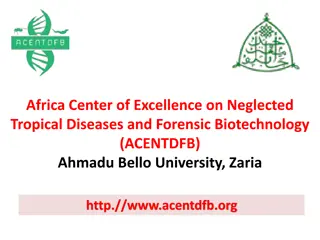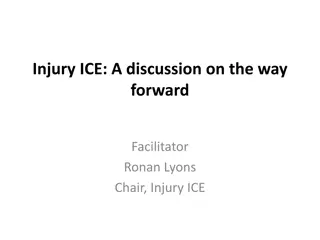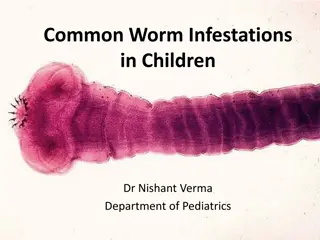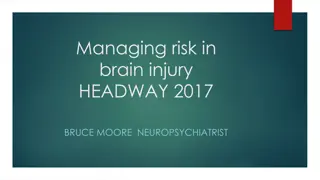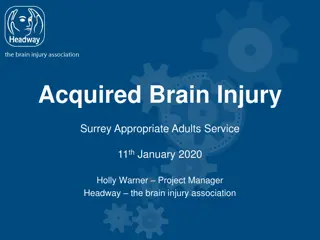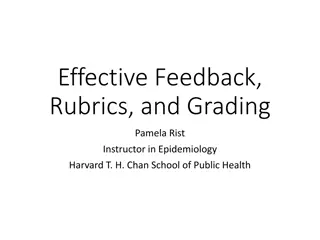Uncovering the Neglected Field of Injury Epidemiology
Exploring the realm of injury epidemiology, this content delves into the definitions, objectives, and hypotheses surrounding the study of injuries. It highlights the overlap between injury epidemiology and prevention while shedding light on why this field remains neglected, particularly in Canada. Through insightful perspectives and engaging imagery, the narrative challenges the perception of injuries as mere accidents and underscores the importance of understanding and preventing injuries.
Download Presentation

Please find below an Image/Link to download the presentation.
The content on the website is provided AS IS for your information and personal use only. It may not be sold, licensed, or shared on other websites without obtaining consent from the author.If you encounter any issues during the download, it is possible that the publisher has removed the file from their server.
You are allowed to download the files provided on this website for personal or commercial use, subject to the condition that they are used lawfully. All files are the property of their respective owners.
The content on the website is provided AS IS for your information and personal use only. It may not be sold, licensed, or shared on other websites without obtaining consent from the author.
E N D
Presentation Transcript
Injury Epidemiology An epidemic of neglect?
My perspective (and COI?) Published first injury paper in 1970 (child seat restraint use) subsequently published over 100 peer reviewed papers on injury prevention all studies employ epidemiologic methods Founding editor of Injury Prevention (BMJ Specialty journal) Co- Founder of Canadian Hospitals Injury Reporting and Prevention Program (surveillance)
Injury defined The word injury, as defined by Baker et al: Injury is the transfer of one of the forms of physical energy (mechanical, chemical, thermal, etc.) in amounts or at rates that exceed the threshold of human tolerance. It may also result from lack of essential energy such as oxygen (for example, drowning) or heat (for example, hypothermia).7" In Haddon s paper, "On the escape of tigers he expounds on the notion of uncontrolled energy transfer as the key element in what constitutes an injury. Injury: a glossary of terms, In J Epidemiology, Hagel and Pless
Objectives To help you understand the current status of injury epidemiology (IE) To explore why it s so neglected (especially in Canada) To encourage you to become involved in this field
Some hypotheses 1. Not old enough 2. Not big enough 3. Not scholarly enough 4. Not taught enough 5. Not costly enough 6. Not unified enough 7. Not Canadian enough
Another for good measure injuries = accidents = bad luck hence, not preventable so why bother?
Injury epidemiology & injury prevention (IP) Overlapping (most IE bears on IP & vice- versa) Injury epidemiology Injury prevention
Neglected? Robertson: mortality statistics but largely ignored by researchers inepidemiology and public health. Near the end of the century,despite a growing body of knowledge . important discussions of the future direction of epidemiological research made no mention of injury. mention of injury,but more was said about Elvis impersonators diseases (but) has no section on injury . For almost two-thirds of the 20th Century, injury deaths were listed in A conference in 2005 on the future of Public Health included one brief The WHOpublication A Safer Future (2007) emphasizes safety from
More neglected in low income countries (LICs) Almost every category of injury fatality is much larger in LICs than in HICs Difference overall is 51 vs 89 per 100,000 Largest difference is war injuries Next largest are traffic and drowning
Death rate by mechanism and economic status Rate per 100,000 per year Mock et al., Lancet 2004; 363 High income countries Low income countries Road traffic 13.6 22.1 Poisoning 2.2 5.8 Falls 8.3 4.0 Fires 1.0 4.5 Drowning 1.7 8.4 Self inflicted 13.3 13.5 Violence 2.8 9.6 War 0.02 6.0 All injury related deaths 51.2 89.1
Less neglected in US (than Canada) In 1985, a National Research Council/Institute of Medicine committee published Injury in America: A Continuing Public Health Problem. The conclusion: Injuries kill more Americans aged 1-34 than all diseases combined; (thus) theyare the leading cause of deaths up to the age of 44. In 1986, a Division of Injury Epidemiology and Control was created in CDC's Center for Environmental Health In 1987, DIE startedfundingspecialized Injury Control Research Centers (ICRC) In 1992, the Division + new program for acute care, rehabilitation, and prevention of injury-related disabilities became CDC s National Center for Injury Prevention and Control
US National Center for Injury Prevention and Control To prevent violence and injuries and reduce their consequences (by) Identifying and monitoring the problem Conducting research to guide decision making Empowering states through funding and technical assistance e.g., WISQARS (Web-based Injury Statistics Query and Reporting System) - an interactive, online database covering fatal and nonfatal injury, violent death, and cost based on several trusted sources
WISQARS Link to website
Injury Control vs Injury Prevention The difference is subtle but important when politics, policy making, and resources are being considered. Injury prevention is largely a matter of primary and secondary prevention, especially secondary. Injury control also involves tertiary prevention preventing tragic outcomes (death, disability, etc.) after an injury has occurred Injury control includes prehospital care ambulances and emergency medical services and emergency or casualty care and rehabilitation Some tension because most preventive resources are consumed by the hospital sector leaving little for traditional public health initiatives
Injury Control Research Centers (ICRCs) conduct research in all three core phases of injury control (prevention, acute care, and rehabilitation) also for training & public information most ICRC research is interdisciplinary (epidemiology, biostatistics, public health, medicine, engineering, law, behavioral and social sciences, biomechanics)
Current 11 ICRCs Columbia University Johns Hopkins School of Public Health University of Iowa University of Michigan Mount Sinai School of Medicine The Research Institute at Nationwide Children's Hospital University of North Carolina at Chapel Hill University of Pennsylvania University of Rochester Medical Center West Virginia University Emory University
Does it matter? That the US has a National Center and Canada does not? The data are inconclusive (partly because some Canadian data are not up-to-date)
US vs Canada US = 40.4 unintentional/100,000 Note: total US rate higher and increases 35.7 to 40.4/100,000 over same time period
My hypotheses Not 5 but 7
1. Not old enough? 1937, Godfrey ES. Role of the Health Department in the Prevention of Accidents, Am J Public Health Nations Health. (? first peer-reviewed) 1938, Holcomb RL. Alcohol in relation to traffic accidents, JAMA 1949, Gordon JE. The epidemiology of accidents. Am J Public Health 1952, De Havens H. The site, frequency and dangerousness of injury sustained in 800 survivors of light plane accidents. Crash Injury Research, Cornell University 1964 Haddon, Suchman, Accident Research: Methods and Approaches, Association for Crippled Children 1980, Haddon Matrix introduced a conceptual basis for prevention, Hazard Prevention 1980, Haddon W. Advances in the epidemiology of injuries as a basis for public health policy, Public Health Reports
Historical landmarks 1980 - advances in injury epidemiology voted by Epidemiology Section of APHA as 1 of 10 landmark achievements in US epidemiology 1992 - US National Center for Injury Prevention and Control became independent program of CDC 1995 - first academic IP journal (Injury Prevention) 1999 - reductions in MV and occupational injury mortality judged 2 of 10 great US public health achievements of 20th century 2000 - WHO established Dept. of Injury and Violence Prevention 2000 E Mackenzie publishes Epi of injuries in Epid Rev 2014 - first academic IE journal (Injury Epidemiology)
Sue Baker Pioneer (Hopkins*) Pilot Artist Epidemiologist Great teacher Good friend *Johns Hopkins Center for Injury Research & Policy
Sue Baker pilot I asked her when and why. Her reply - (Started) in 1986, when I was 56, which was old for a student pilot and stopped about 8 or 10 years ago. I took it up because I wanted to do research on aviation crashes, and needed to understand what is required of pilots. Getting my license opened a lot of doors e.g., pilots lectured in the course I started on aviation safety and some airlines allowed me to fly jump-seat on the flight deck, right behind the captain, on any flight where I was a ticketed passenger. (Also gave her more data about pilot behaviour)
2. Not big enough? Consider death rates Canada 2005
Causes of death, Canada, 2011 ages 15 to 24 & 25 to 34 years 900 800 700 600 500 400 15 to 24 300 25 to 34 200 100 0
Causes of death, Canada, 2011 Condition Number % Cancer 72,000 30 Heart 48,000 20 Injury (int & unintentional) 15,000 5.9 Cerebrovascular 13,000 5.5 Chronic lower respiratory 11,000 4.6
Global problem WHO Global Burden of Disease -- injuries are Increasingly themajor problem in third world countries (LICs), especially MV crashes, and they are rising rapidly. If present trends continue, road traffic injuries are predicted to be the third-leading contributor to the global burden of disease and injury by 2020.
3. Not scholarly enough? Books and Journals
But many injury epidemiology books Most focus on prevention Come visit my bookshelf
Other books Hemenway D. While We Were Sleeping: Success Stories in Injury and Violence Prevention (2009) Roberts I. The Energy Glut: Climate Change and the Politics of Fatness (2010) Li G, Baker S. Injury Research: Theories, Methods, and Approaches (2012) Liller K, Injury Prevention for Children and Adolescents: Research, Practice, and Advocacy, 2nd Edition (2012) Barss P, Smith G, Baker S, Mohan D. Injury Prevention: An International Perspective: Epidemiology, Surveillance, and Policy Christoffel K, Gallagher S. Injury Prevention And Public Health: Practical Knowledge, Skills, And Strategies
. and several key journals peer reviewed & respectable IFs (for whatever that s worth!)
Injury Epidemiology Contents Journal The contents give some idea of the range of topics included in IE
IE Scope & Policy Scope: magnitude, distribution, determinants, causes, prevention, diagnosis, treatment, prognosis, and outcomes of injuries in specific population groups, geographic regions, and environmental settings Policy: priority given to papersthat feature contemporary theories, innovative methods, and novel techniques applied to injury surveillance, risk assessment, effective interventions, and program/policy evaluation
Table of contents Original Article: Using a virtual environment to study child pedestrian behaviours: a comparison of parents' expectations and children's street crossing behaviour (22 Sep 2015) Original Article: Scald burns in children under 3 years: an analysis of NEISS narratives to inform a scald burn prevention program (22 Sep 2015) Original Article: An examination of concussion education programmes: a scoping review methodology (22 Sep 2015) Original Article: Defining a safe player run-off zone around rugby union playing areas (22 Sep 2015) Original Article: Influence of voluntary standards and design modifications on trampoline injury in Victoria, Australia (22 Sep 2015) Original Article: Investigating the fall-injury reducing effect of impact absorbing flooring among female nursing home residents: initial results (22 Sep 2015) Methodology: Validation of ICDPIC software injury severity scores using a large regional trauma registry (22 Sep 2015) Anniversary Archives: Australia's 1996 gun law reforms: faster falls in firearm deaths, firearm suicides, and a decade without mass shootings (22 Sep 2015) News And Notes: Global news highlights (22 Sep 2015)
And a few others J of Injury and Violence reserch J of Safety Research Safety Science Transportation Research
